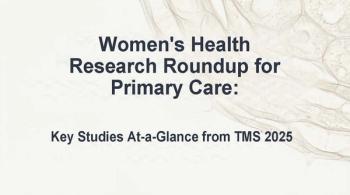
Health and Access to Care Help Explain Differences in Arthritis Disability Risk
CHICAGO -- Racial and ethnic differences in the rate at which older adults with arthritis become disabled by the condition may be largely a function of overall health and access to care, researchers found.
CHICAGO, July 30 -- Racial and ethnic differences in the rate at which older adults with arthritis become disabled by the condition may be largely a function of overall health and access to care, researchers found.
In a study of older Americans with arthritis, African-Americans and Spanish-speaking Hispanics were nearly twice as likely as English-speaking Hispanics and whites to develop limitations in activities of daily living over a six-year period, said Jing Song, M.S., of Northwestern University here, and colleagues.
Together, comorbid conditions, functional limitations, and health behaviors accounted for more than half of the excess risk among the minority groups, they reported in the August issue of Arthritis Care & Research.
Health insurance and other medical access factors, such as education and income, were substantial mediators of differences as well, they noted.
Previous studies had discovered racial and ethnic disparities in risk of disability in this population, but the reasons behind it were not clear.
So, the researchers analyzed data from the nationally-representative sample of 7,257 participants in the larger Health and Retirement Study who self-reported arthritis and were initially disability free.
The study surveyed adults 51 and older about arthritis and ability to perform activities of daily living (dressing, walking across a room, getting in or out of bed, bathing, eating and using the toilet) in 1998, 2000, 2002, and 2004.
Most of the cohort was white (85.5%), 9.3% were African-American, 2.4% were Hispanics who spoke Spanish, and 2.9% were Hispanics who spoke English. The average age at baseline was 66.7.
The researchers distinguished between language groups for Hispanic participants as a proxy for acculturation.
After six years of follow-up, 17.7% of participants had developed disability in at least one activity of daily living.
The six-year incidence rates were:
- 28.0% among African-Americans (adjusted hazard ratio 1.94 versus whites, 95% confidence interval 1.51 to 2.38).
- 28.5% among Spanish-speaking Hispanics (adjusted HR 2.03 versus whites, 95% CI 1.35 to 2.71).
- 19.1% among English-speaking Hispanics (adjusted HR 1.41 versus whites, 95% CI 0.82 to 2.00).
- 16.2% among whites.
Overall, health factors -- chronic comorbidities, functional and physical limitations, smoking, alcohol use, exercise, and weight -- appeared to explain the majority of the excess risk among minorities. The findings were:
- Adjusting for health factors reduced risk among African-Americans by 55% (adjusted HR 1.42).
- Adjusting for health factors reduced risk among Spanish-speaking Hispanics 60% (adjusted HR 1.41).
- Adjusting for health factors among English-speaking Hispanics left risk essentially unchanged (adjusted HR 1.42).
- Each health factor explained 28% to 35% of excess risk for African-Americans and Spanish-speaking Hispanics.
Likewise, medical access factors -- education, income, net wealth, and health insurance -- explained a substantial proportion of excess risk. Adjusting for medical access reduced hazard ratios by 60% for African-Americans, 95% for Spanish-speaking Hispanics, and 73% for English-speaking Hispanics.
But controlling for health factors and demographics, medical access reduced risk only an additional 12% for African-Americans (adjusted HR 1.31), 20% for Spanish-speaking Hispanics (adjusted HR 1.20), and 24% for English-speaking Hispanics (adjusted HR 1.32).
Furthermore, controlling for the other risk factors eliminated most medical access factors as significant predictors of developing disability. Only enrollment in Medicaid (adjusted HR 1.65) and Medicare or other public health insurance (adjusted HR 1.41) remained significant.
The reason for differences between language groups among Hispanics may be related to "disadvantages stemming from limited educational and occupational choices, and social stress related to poverty," the researchers noted.
However, the language differences may also reflect a different cultural paradigm for health and illness, they cautioned. Other unmeasured factors may have contributed to disability in the other groups as well, such as occupation and its demands, living conditions, and segregation, they added.
Song and colleagues also acknowledged that the study had no information on disease severity and relied upon self-reporting.
Nonetheless, "at the clinical level, not only should treatment of comorbid conditions be considered, but also disease prevention, prevention and treatment of functional limitations, and promotion of healthy behaviors should be a priority for all patients with arthritis to prevent the development of disability," the investigators concluded.
Newsletter
Enhance your clinical practice with the Patient Care newsletter, offering the latest evidence-based guidelines, diagnostic insights, and treatment strategies for primary care physicians.


















































































































































































































































































